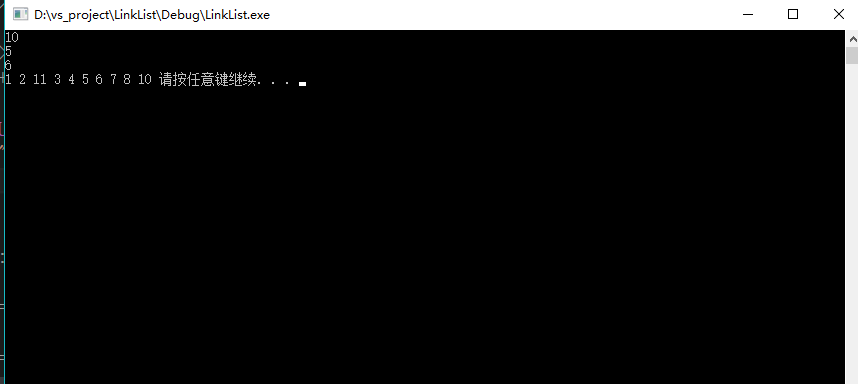C++實現線性表的鏈接存儲結構(單鏈表)
阿新 • • 發佈:2017-12-19
mage pac lis ins 尾插 初始化 arr space ios
將線性表的抽象數據類型定義在鏈接存儲結構下用C++的類實現,由於線性表的數據元素類型不確定,所以采用模板機制。
1 頭文件linklist.h 2 #pragma once 3 #include <iostream> 4 // 單鏈表的節點 5 template<class T> 6 struct Node 7 { 8 T data;//數據域 9 Node<T> *next;// 指針域,指向後繼節點 10 }; 11 // 單鏈表的類實現 12 template<class T> 13 class LinkList14 { 15 public: 16 LinkList();// 無參構造函數,建立只有頭節點的空鏈表 17 LinkList(T a[],int n);// 有參構造函數,建立有n個元素的單鏈表 18 ~LinkList();// 析構函數 19 int Length();// 求單鏈表的長度 20 T Get(int i);// 查找第i個元素 21 int Locate(T x);// 查找值為x的元素 22 void Insert(int i, T x);// 在第i個元素處插入x 23 T Delete(int i);// 刪除第i個節點24 void PrintList();// 遍歷各個元素 25 private: 26 Node<T>* first;// 單鏈表的頭節點 27 }; 28 29 template<class T> 30 inline LinkList<T>::LinkList() 31 { 32 first = new Node<T>; // 生成頭節點 33 first->next = NULL; // 頭節點指針域為空 34 } 35 36 // 頭插法建立單鏈表 37 template<classT> 38 LinkList<T>::LinkList(T a[], int n) 39 { 40 first = new Node<T>; 41 first->next = NULL; // 初始化一個空鏈表 42 for (int i = 0; i < n; i++) 43 { 44 Node<T>* S = new Node<T>; 45 S->data = a[i]; // 為每個數據元素建立一個節點 46 S->next = first->next; 47 first->next = S; // 將節點S插入頭節點之後 48 } 49 } 50 // 尾插法建立單鏈表 51 template<class T> 52 LinkList<T>::LinkList(T a[], int n) 53 { 54 first = new Node<T>;// 建立頭節點 55 first->next = NULL; 56 Node<T>* r = first;// 尾指針初始化 57 for(int i = 0; i < n; i++) 58 { 59 Node<T>* S = new Node<T>; 60 S->data = a[i]; // 為每個數據元素建立一個節點 61 r->next = S; 62 r = S; // 插入節點S,並將尾指針指向S節點 63 } 64 r->next = NULL; // 單鏈表建立完畢之後,將尾指針置空 65 } 66 67 template<class T> 68 LinkList<T>::~LinkList() 69 { 70 while (first != NULL) 71 { 72 Node<T>* p = first; // 暫存將被釋放節點 73 first = first->next; // 指向下一個節點 74 delete p; 75 } 76 } 77 78 template<class T> 79 int LinkList<T>::Length() 80 { 81 int count = 0; // 計數 82 Node<T>* p = first->next; // 將工作指針指向第一個節點 83 while (p != NULL) 84 { 85 count++; 86 p = p->next; 87 } 88 return count; 89 } 90 91 template<class T> 92 T LinkList<T>::Get(int i) 93 { 94 int count = 0; // 計數 95 Node<T>* p = first->next; // 將工作指針指向第一個節點 96 while (p != NULL) 97 { 98 count++; 99 if (count == i) 100 return p->data; 101 p = p->next; 102 } 103 return -1; // 越界 104 } 105 106 template<class T> 107 int LinkList<T>::Locate(T x) 108 { 109 int count = 0; // 計數 110 Node<T>* p = first->next; // 將工作指針指向第一個節點 111 while (p != NULL) 112 { 113 count++; 114 if (p->data == x) 115 return count; 116 p = p->next; 117 } 118 return 0; // 查找失敗 119 } 120 121 template<class T> 122 void LinkList<T>::Insert(int i, T x) 123 { 124 int count = 0; // 計數 125 Node<T>* p = first; // 將工作指針指向頭節點 126 while (p != NULL) 127 { 128 if (count == i - 1) // 找第i-1個節點 129 { 130 Node<T>* S = new Node<T>; 131 S->data = x; 132 S->next = p->next; 133 p->next = S; 134 } 135 p = p->next; 136 count++; 137 } 138 if (p == NULL) 139 throw "位置越界"; 140 } 141 142 template<class T> 143 T LinkList<T>::Delete(int i) 144 { 145 int count = 0; // 計數 146 Node<T>* p = first; // 將工作指針指向頭節點 147 while (p != NULL) 148 { 149 if (count == i - 1) 150 { 151 Node<T>* q = p->next;// 暫存被刪節點 152 T x = q->data; 153 p->next = q->next; 154 delete q; 155 return x; 156 } 157 p = p->next; 158 count++; 159 } 160 return -1; 161 } 162 163 template<class T> 164 void LinkList<T>::PrintList() 165 { 166 Node<T>* p = first->next; // 將工作指針指向第一個節點 167 while (p != NULL) 168 { 169 cout << p->data << " "; 170 p = p->next; 171 } 172 }
主函數 #include"linklist.h" using namespace std; int main() { int arry[10] = { 1, 2, 3, 4, 5, 6, 7, 8, 9, 10 }; LinkList<int>* linklist = new LinkList<int>(arry, 10); cout << linklist->Length() << endl; cout << linklist->Get(5) << endl; cout << linklist->Locate(6) << endl; linklist->Insert(3, 11); linklist->Delete(10); linklist->PrintList(); system("pause"); return 0; }
運行結果如下:

C++實現線性表的鏈接存儲結構(單鏈表)
